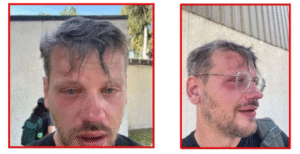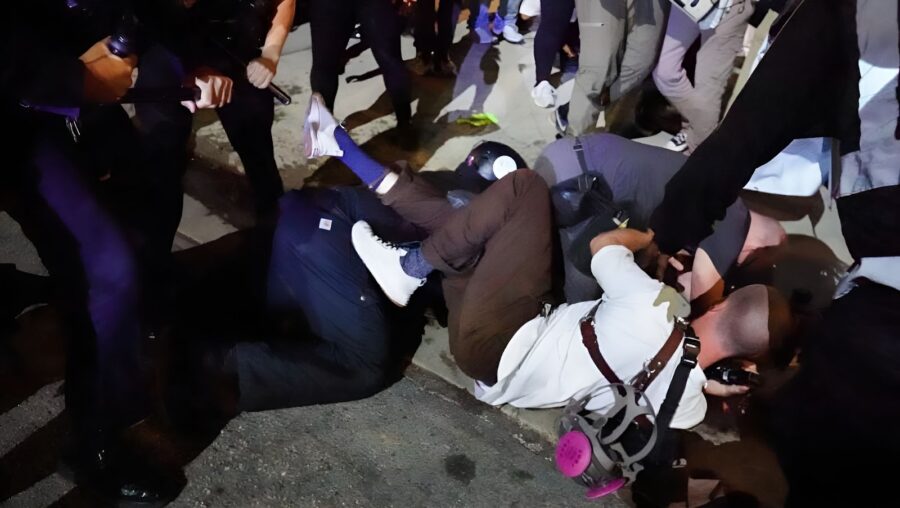Published in partnership with Rolling Stone.
In the weeks since President Donald Trump targeted American cities for “the single largest Mass Deportation Program in history” and deployed U.S. troops to the streets of Los Angeles, federal and local law enforcement officers have repeatedly assaulted and seriously injured journalists, legal observers, and protesters, according to filings in a federal lawsuit.
That violent conduct by Department of Homeland Security (DHS) agents is “ongoing,” “sustained,” and “officially sanctioned,” plaintiffs claim in LA Press Club v. DHS, which is scheduled to be heard before a judge on August 25.
The evidence marshaled in the case shows “serious threats to journalists coming in the form of completely unchecked violence from DHS officers,” Peter Eliasberg, chief counsel at the American Civil Liberties Union (ACLU) of Southern California, told the Center for Media and Democracy (CMD).
Eliasberg and other ACLU lawyers are acting as co-counsel in the lawsuit for the Los Angeles Press Club, the NewsGuild–Communications Workers of America (a union representing thousands of journalists and media workers across the country), and individual plaintiffs assaulted or injured by law enforcement officials.
The Los Angeles Press Club filed a similar lawsuit against the Los Angeles Police Department (LAPD) in June and won a temporary restraining order barring the police from restricting media access at protests, assaulting journalists, or using “less lethal munitions…and other crowd control weapons against them.” It has also sued the LA County Sheriff’s Department (LASD) for violence against reporters during the June crackdown on protests.
In interviews with CMD, journalists said that the violence meted out by law enforcement outside of Immigration and Customs Enforcement raids and related protests goes well beyond what they have experienced at earlier protests — or indeed in conflict zones. That includes firing tear gas and “less lethal” munitions like rubber bullets at people’s heads, “smashing the hands of people recording the events with their phones,” and “indiscriminately firing into crowds,” according to the court filings.
“What we are seeing is…egregious use of force directed at journalists and legal observers when it’s clear that journalists are just trying to do their jobs and don’t pose any threat to DHS,” Eliasberg told CMD. “The only reasonable inference as to the way DHS is behaving is that they are simply retaliating against journalists for exercising their First Amendment rights to cover the news.”
ACLU lawyers are representing the plaintiffs in the press lawsuits against both DHS and LAPD.
Injured Journalists Speak Up
The results of this unchecked violence are very real. On June 7, a Homeland Security Investigations officer hit Los Angeles-based videographer Sean Beckner-Carmitchel in the eye with a projectile at a well-documented raid on day laborers outside a Home Depot in Paramount, California, about 10 miles south of Los Angeles, Beckner-Carmitchel told CMD.
“I was filming what appeared to be a large-scale immigrant detention operation, and a large-scale protest response,” he said. “When I got there… a huge [number] of vehicles and agents [were] standing across the street from Home Depot… hitting protesters with less lethal munitions…. Some of the chemical munitions were hitting brush and they were being so reckless with it that they actually started two fires. The fires were small but still extremely concerning.”
After filming for several hours, Beckner-Carmitchel thought the raid and protest were calming down. “So I took a break, took off my helmet, and prepared to leave,” he explained. “Then I heard a really big explosion next to my face. I could feel the spinning and numbing sensation ringing in my ear. At that point, I Frankenstein walked about a block and half out of there [to get] medical attention. I had to go to the hospital, got a really nasty welt, and I’m really lucky it wasn’t worse.”

Sean Beckner-Carmitchel’s injuries, from court filings
Jeremy Lindenfeld, who was at a June 6 protest in front of Los Angeles’ Metropolitan Detention Center (MDC), told CMD that “DHS officers were firing pepperballs and tear gas in front of MDC,” which impacted many journalists even though they had clearly identified themselves. “The next day, on June 7, border patrol agents were indiscriminately firing projectiles” with little concern for discerning between protesters and journalists.
Violent activity directed at journalists was not limited to DHS officers, however. Nick Stern, who has decades of experience as a photojournalist in conflict zones, was hit with an exploding projectile fired by a LASD officer despite being clearly identified as a member of the press.
“I’ve covered protests for 30 years,” Stern told CMD. “I’m always making sure that I’m very visible with ID on my neck, not hiding.” But that didn’t help on June 7 when he was hit while photographing at the same Home Depot raid in Paramount. “As the evening wore on, [there were] skirmishes … between protesters and the Sheriff’s Department.” Just before 9 pm, he was “photographing protesters doing nothing more than flying the Mexican flag,” he recounts, when he “suddenly felt this excruciating pain” in his right leg. A projectile “must have been fired from extremely close range,” he realized before passing out from the pain. Once he was rushed to the hospital, the ER doctors “were looking for an exit wound and found the plastic casing of “an exploding projectile, a flash bang” embedded in his thigh.
Since being shot, Stern says that he has been suffering from panic attacks and nightmares, and still has an open wound in his thigh two months later. He experiences significant pain when he walks more than 20 or 30 feet and says, “I have to do a lot of daily exercise, which is quite painful, to get strength and stability back in my leg.”
On Friday, August 8, Stern was assaulted again while photographing a protest, this time by an officer on the LAPD, who smacked him across the face with a baton, lacerating his face and chin, Stern said. The police also injured two other journalists and arrested two others — despite a federal injunction prohibiting them from harming journalists who are simply trying to do their jobs.
On August 13, the LA Press Club asked the federal court to find the LAPD in contempt and issue sanctions.
DHS and the LAPD did not respond to requests for comment as of press time. The LASD told CMD that they do not “deploy less-lethal tools indiscriminately. Such tools are used only when all de-escalation efforts have been exhausted and when deputies, other law enforcement personnel, or members of the public are subjected to violent assaults involving dangerous projectiles.”
Other plaintiffs in the DHS litigation report being hit in the head with rubber bullets, shot with pepperballs, and sprayed with tear gas. An ABC 7 news truck was attacked by DHS agents, with a journalist reporting that “tear gas canisters started flowing, less than lethal rounds started deploying, and my photographer got hit twice by less than lethal rounds, [ending up with] blood on one of his arms.” The entire news team had to “flee” as a result, legal declarations stated.
Adam Rose, chair of the LA Press Club’s press rights committee, told CMD that the organization has documented more than 100 cases of law enforcement misconduct since June. “There was only one incident of a journalist arrested outright, but it was egregious,” Rose said. “They held someone in jail for four days with no charges.”
“We’re concerned that these agencies require some higher authority to control them,” Rose said, providing the justification for the three lawsuits against the LAPD, LASD, and DHS. “The Sheriff’s Department case is furthest behind….In the DHS case, there [have] been some developments after an initial setback. The judge on the case initially decided to not issue a temporary restraining order,” reasoning that all of the alleged harms had occurred during a four-day period in June, and plaintiffs had submitted no evidence of recurring misconduct.
The case has since been reassigned to U.S. District Judge Hernan Vera, who is handling the LAPD case, based on similar legal and factual issues. But the plaintiffs have also filed new declarations alleging additional assaults by DHS in late June and early July.
The plaintiffs’ proposed order argues that DHS has engaged in an “ongoing, sustained pattern of conduct that [has] resulted in numerous injuries to members of the press, legal observers, and protesters…that has persisted for weeks.”
Given that DHS has continued to engage in violent behavior in the aftermath of the initial volleys in early June, Rose is “hopeful” that the judge in that case will recognize that there is “a pattern here” and issue a preliminary injunction.



Leave a Reply